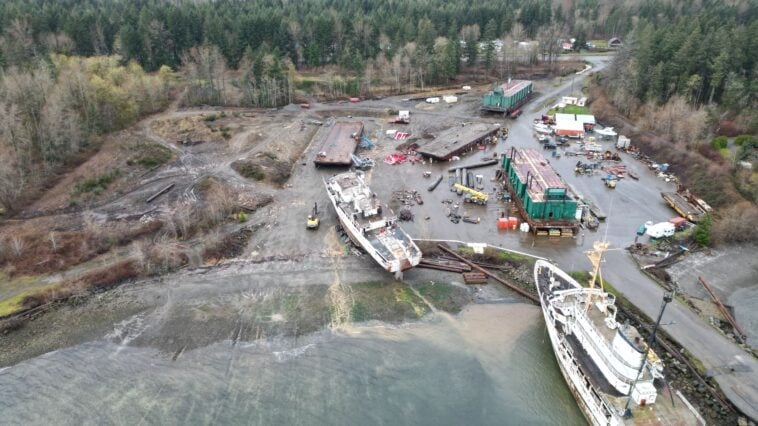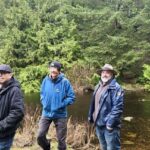Baynes Sound, a biologically rich marine region off the east coast of Vancouver Island, is at the centre of an escalating environmental controversy. Deep Water Recovery (DWR), a shipbreaking and retrofitting facility operating in Union Bay, has been accused of repeatedly discharging high levels of toxic metals into the ocean without permits or proper waste containment. Residents and Indigenous leaders are demanding immediate intervention from government authorities.
“We know it isn’t a matter of if, but rather, when something environmentally damaging is going to happen with these harmful activities.”
K’ómoks First Nation Hegus (Chief Councillor) Nicole Rempel
According to the community group Concerned Citizens of Baynes Sound (CCOBS) and documents from the BC Ministry of Environment, the facility has violated pollution regulations multiple times since 2017, an issue The Skeena reported on in 2024. Contaminants such as copper, lead, zinc, cadmium, and PCBs have been released into the water at concentrations far exceeding provincial safety limits, with copper levels reaching as high as 2,750 percent above allowable thresholds. Despite receiving 16 official warnings and a pollution abatement order, the facility continues to operate without a functioning treatment system or approved permit.
A Region of Ecological and Cultural Significance

Baynes Sound is located within the unceded traditional territory of the K’ómoks First Nation. The Nation has long relied on these waters for food, ceremony, and cultural connection. In a 2021 press release, the K’ómoks leadership warned that DWR’s operations posed an environmental risk to the region.
According to Hegus (Chief Councillor), Nicole Rempel, “There are no federal or provincial regulations in place for the deconstruction of ships on land. Until it’s too late and an actual environmental impact happens, there is nothing holding the company accountable, just voluntary adherence to the guidelines they’ve set for themselves. We know it isn’t a matter of if, but rather, when something environmentally damaging is going to happen with these harmful activities.”
This coastal zone holds multiple conservation designations. It is classified as an Ecologically and Biologically Significant Area (EBSA) by Fisheries and Oceans Canada (DFO), an Important Bird Area (IBA) supporting over 10,000 migratory birds, and a Key Biodiversity Area. Three of the seven named EBSAs along Vancouver Island’s east coast are located within Baynes Sound, highlighting its ecological importance on both a regional and national scale.
The area is also home to eelgrass beds, which act as nurseries for juvenile salmon, and more than 15 salmon-bearing streams. Hart Creek, located just one kilometre south of DWR, hosts runs of coho, chum, steelhead, and cutthroat. Pacific harbour seals, Steller sea lions, and sea otters also feed in the region.
Moreover, the region is home to the province’s largest concentration of shellfish farms, making it important for BC’s aquaculture and fisheries economy.
The Vital Role of Herring in Baynes Sound and Lambert Channel
Baynes Sound and neighbouring Lambert Channel are also among the most important herring spawning and rearing habitats in British Columbia. Each spring, millions of Pacific herring return to spawn, triggering a cascade of ecological activity that fuels marine and bird life across the region.
Herring serve as a keystone species. Their spawn supports migrating seabirds—some at risk of extinction—as well as juvenile salmon and other forage fish that rely on the nutrient-rich event. Marine mammals, including humpback whales and orcas, also depend on this annual influx of food.
“Baynes Sound is home to the highest density of intertidal shellfish farming in British Columbia. The discharge of pollutants like copper, lead, and cadmium from DWR’s shipbreaking operations threatens the health of shellfish populations, which are vital to the local economy.”
Concerned Citizens of Baynes Sound
The region’s complex food chain could be broken entirely if just one species goes into decline. Herring are especially sensitive to pollution, with contaminants like heavy metals and hydrocarbons interrupting spawning cycles and contributing to population crashes. The toxic runoff from shipbreaking not only endangers herring but also affects shellfish, salmon, and the broader food web.
Concerned Citizens of Baynes Sound warn that pollution introduced into Baynes Sound does not remain isolated—it spreads across the Salish Sea, impacting other coastal regions and communities.
Pollution, Toxic Spread, and Shellfish Closures
According to the Concerned Citizens of Baynes Sound (CCOBS), independent laboratory tests conducted as part of the provincial Environmental Impact Assessment reveal that DWR’s effluent contains heavy metals and chemicals that are harmful to marine life even at low concentrations. CCOBS also said in a statement to The Skeena that effluent from the shipbreaking operations has been observed flowing into Baynes Sound. In toxicity tests, rainbow trout exhibited severe reactions to the contaminated water. Some of these pollutants—such as PCBs—are known to bioaccumulate in marine organisms and persist in the environment for decades.
“Baynes Sound is home to the highest density of intertidal shellfish farming in British Columbia. The discharge of pollutants like copper, lead, and cadmium from DWR’s shipbreaking operations threatens the health of shellfish populations, which are vital to the local economy,” said CCOBS in their statement.
“Tourism in Baynes Sound, especially eco-tourism activities like birdwatching and wildlife viewing, is at risk due to the environmental degradation caused by shipbreaking.”
Concerned Citizens of Baynes Sound
Water movement studies show that the contaminants do not remain near the discharge site. Instead, ocean currents carry the pollution southward toward Hart Creek and shellfish aquaculture areas. Since 2017, a sanitary closure has been in place for shellfish harvesting around the facility, which the Ministry of Environment report suggests is linked to the contamination. These closures have directly impacted local fisheries and the availability of traditional Indigenous food sources.
“Considering the other environmental impacts in the area, such as a leaching coal slag heap and faulty septic tanks, why would we jeopardize this area further?” asks K’ómoks First Nation Chief Councillor Nicole Rempel. “Where do we draw the line?”
“Tourism in Baynes Sound, especially eco-tourism activities like birdwatching and wildlife viewing, is at risk due to the environmental degradation caused by shipbreaking,” added CCOBS.
Repeat Offences, Limited Accountability
From at least September 2023 to February 2024, DWR released unauthorized effluent into Baynes Sound on at least seven documented occasions. Despite a formal Pollution Abatement Order in March 2024 and numerous warnings dating back to April 2022, inspections in late 2024 and early 2025 confirmed that the company was still out of compliance. A January 2025 review by Ministry Officer Jurgen Deagle reported copper levels over 1,000% above short-term water quality guidelines.
The Ministry of Environment issued a $48,300 fine and concluded that the company had avoided an estimated $10,800 in costs by not implementing proper waste treatment systems.
The Environmental Appeal Board denied DWR’s request for a stay of enforcement in mid-2024, noting that ongoing contamination had been clearly demonstrated. Nevertheless, the facility continues to operate next to residential neighbourhoods and critical fish habitats.
Lack of Oversight for Shipbreaking Operations
Concerned Citizens of Baynes Sound have drawn attention to what they see as a troubling regulatory gap. While residents must apply for permits to build small sheds, large industrial shipbreaking operations like DWR are operating without required permits, site plans, or inspections. There are no limits on the size of vessels being dismantled, no regulations guiding the disposal of hazardous materials, and no accountability for toxic runoff entering local ecosystems.
“The only interactions have been in the form of harassment and cease-and-desist letters directed at Concerned Citizens of Baynes Sound.”
Concerned Citizens of Baynes Sound
The group notes that shipbreaking involves exposure to substances such as asbestos, lead-based paints, and antifouling coatings. Yet, provincial oversight has remained minimal. No government agency has conducted regular inspections, and no systems are in place to track or safely manage hazardous waste produced during vessel dismantling.
Furthermore, a spokesperson from CCOBS said there has been no meaningful communication between Deep Water Recovery and the community: “The only interactions have been in the form of harassment and cease-and-desist letters directed at Concerned Citizens of Baynes Sound,” adding that “this failure to initiate any proactive communication has created a hostile atmosphere, further alienating the local community.”
Baynes Sound: A Candidate for Marine Protected Area Status?
Concerned Citizens of Baynes Sound is now advocating for Baynes Sound to be designated as a Marine Protected Area (MPA) under the federal Oceans Act. They argue that such protection is urgently needed given the ecological, cultural, and economic importance of the area—and the active threats it faces.
“The Baynes Sound KBA (Key Biodiversity Area) covers an area of approximately 100.87 km2, though only 1.77% of the area is formally protected,” said CCOBS in their statement to The Skeena.
According to the group, the reasons Baynes Sound meets the criteria for MPA designation include:
- supporting vital spawning and rearing habitats for herring and salmon, foundational species in the marine food web
- being a key stopover site for migratory seabirds and waterfowl
- containing significant eelgrass and benthic habitats crucial to juvenile fish and carbon sequestration
- providing habitat for marine mammals, including seals and sea lions
- being culturally significant to the K’ómoks First Nation, whose 2024 treaty reinforces Indigenous-led conservation
- sustaining aquaculture, fisheries, and eco-tourism critical to the local economy
A Call for Government Action
“The response from government agencies has been inadequate and has not addressed the concerns effectively,” said CCOBS in a statement. “Agencies like DFO and ECCC have blamed each other for jurisdictional issues, delaying concrete action to stop the pollution.”
Despite multiple warnings from the BC Ministry of Environment and civil action from the Comox Valley Regional District, no enforcement action has halted operations.






I am proud to serve as the current President of Concerned Citizens of Baynes Sound. This article highlights the urgent need for action and for ship-breaking regulation in Canada. As a not-for-profit society, we depend on the sale of memberships to continue our work. We would appreciate your support by visiting CCOBS.wordpress.com and clicking Membership.
I do not understand our stupid government for allowing this toxic activity to exist not just in Baynes Sound but any where on any beach in Canada. People have been fined millions of dollars and the loss of their boat and equipment for over fishing. Nothing happens to this business.